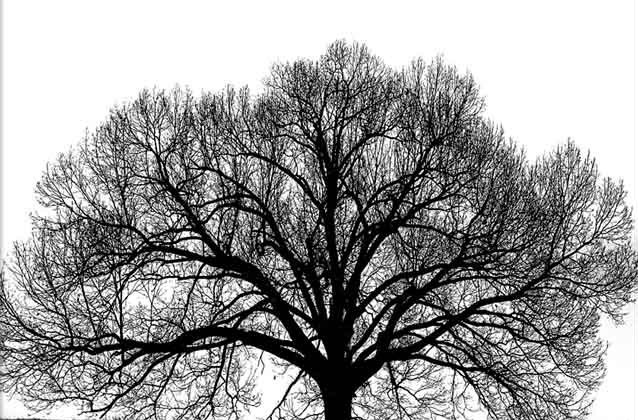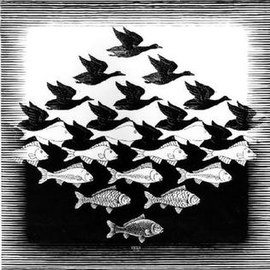-
 Banno
29.9kEither get engaged in the discussion or keep out of it. — Luke
Banno
29.9kEither get engaged in the discussion or keep out of it. — Luke
This from the preson who claims not to know what "...from left to right" means:What do you mean by "from left to right"? — Luke
Come on.

The colour does not change over time. It does change over the distance from left to right.
Hence there is a change over distance that does not involve a change over time. -
 Agent Smith
9.5k
Agent Smith
9.5k
WARNING! Contains flashing images (A very small percentage of individuals may experience epileptic seizures when exposed to certain light patterns or flashing lights. Exposure to certain patterns or backgrounds on a computer screen, or while playing video games, may induce an epileptic seizure in these individuals. Certain conditions may induce previously undetected epileptic symptoms even in persons who have no history of prior seizures or epilepsy.)
No change in distance, color change in time only in the video above.
Compare that to @Banno's image.
Where C = color, S = distance, T = time, and = change,
Banno's image is
The question is, can distance change in the absence of change in time ?
Motion! Motion! Motion! and...Time! -
 Luke
2.7kHow can the change have a direction without time?
Luke
2.7kHow can the change have a direction without time?
You said that the colour "changes over the distance from left to right".
I think I understand what you mean by the distance - I take it you mean the horizontal length of the image. But I can't make much sense of directionality without time. Do you mean that the change occurs or happens from left to right? Do you mean that the colour change can be seen in the image if we look at it "from left to right"? Can you provide any explanation about what you meant by "from left to right"? -
 Pierre-Normand
2.9kIndeed, this is apparent. I do not understand how you think like this. You can see that the left of the image is a different colour to the right. — Banno
Pierre-Normand
2.9kIndeed, this is apparent. I do not understand how you think like this. You can see that the left of the image is a different colour to the right. — Banno
Nobody is denying that there is a difference. The question is, how do you infer a change (especially a change that, in your own words, "occurs") from a difference that is, quite clearly, a difference between two or more separate things such as the parts of an image?
The main point of Kant's Second Analogy of Experience was to analyse what's required, conceptually, to differentiate a mere subjective difference between two percepts, that may or may not refer to two different objects, or to any object at all, from the perception of an objective change in something that's empirically real. Merely having two different percepts doesn't indicate that anything changed appart from your own state of mind. Those two percepts must refer to the same objective thing that had, first, some quality and then some other quality. This thing, or substance, must have those qualities at two different times since something can't have two inconsistent qualities at the same time. This is how the concepts of change and time are bound up into the concept of a substance: an objective thing in the world that is the cause of our varying perceptions of it. -
 sime
1.2kChange vs Difference:
sime
1.2kChange vs Difference:
In terms of McTaggart's B series, every temporal referent, e.g. date, is different - by definition of "referent" . This is used in calendar logic, but also applies to the above colour difference picture in which one instantaneously recognizes more than one colour referent. In both calendar logic and the above picture, what is called "difference" is recognized without any concept of temporal passage coming into play. ( a stimulus-response to an image shouldn't be interpreted as being an inference, because the future is irrelevant as far as the stimulus-response is concerned)
"Change" refers to two referents being associated with the same indexical. For example, if one thinks that "now" becomes "now", then one creates the confusion of temporal passage. But if instead one thinks of the first act of "now" as referring to '09:09 on 26th Jan' and the second act of "now" as referring to '09:10, 26th Jan' then no change can be acknowledged. -
 Pierre-Normand
2.9kAnd yet it changes.
Pierre-Normand
2.9kAnd yet it changes.
So his account is problematic. — Banno
You still are using the word "it" ambiguously in order to trade on an equivocation. Suppose your image were replaced with an image depicting two distinct squares sitting next to each other with no overlap. The square on the left is red and the square on the right is blue. Would you say that, from left to right, "it" changes from red to blue? What would "it" refer to in order for that claim to make sense? There are two different squares and they don't change. By contrast, when a green apple ripens and turns red, the apple that was green and the apple that is now red are numerically identical. They're the same object and this object changed. An object doesn't change through merely replacing it with a different object, let alone by dint of shifting our attention to a different object that's located elsewhere. -
 Agent Smith
9.5kStart/beginning and finish/ending: Kairos (ordinal time, we'll start our meeting at 6:00 PM, the meeting ended at 7:00 PM)
Agent Smith
9.5kStart/beginning and finish/ending: Kairos (ordinal time, we'll start our meeting at 6:00 PM, the meeting ended at 7:00 PM)
Middle: Chronos (cardinal time, the meeting lasted for 1 hour) -
 Metaphysician Undercover
14.6kYour denying this is for me of a par with MU's denial of instant velocity; it leaves me nonplussed. — Banno
Metaphysician Undercover
14.6kYour denying this is for me of a par with MU's denial of instant velocity; it leaves me nonplussed. — Banno
There's no rigour in modern word usage. Rigor mortis has set in. -
 Banno
29.9kAll you seem to be doing here is stipulating that change requires change. If you do that then you are simply placing yourself at odds with everyday use.
Banno
29.9kAll you seem to be doing here is stipulating that change requires change. If you do that then you are simply placing yourself at odds with everyday use.
Your squares example is gratuitous. There is no equivocation; the colour changes over distance.

Notice that the branches change, becoming thinner and more numerous towards the top of the tree?

Notice that the white space changes to fish, the back space to birds? Again, over distance, not over time. -
 Pierre-Normand
2.9kAll you seem to be doing here is stipulating that change requires change. If you do that then you are simply placing yourself at odds with everyday use.
Pierre-Normand
2.9kAll you seem to be doing here is stipulating that change requires change. If you do that then you are simply placing yourself at odds with everyday use.
Your squares example is gratuitous. There is no equivocation; the colour changes over distance. — Banno
I would not be placing myself at odds with everyday use by claiming that bears are essentially mammals even though there are perfectly good everyday uses of the word "bear" where it is meant to refer to a plush toy. The latter use is derivative from the former one. There is not one single sort of thing called "change" that material entities often undergo when time passes and that can also occur over distance. You are the one disregarding variations in ordinary word usage. My main point is that the existence of the latter use doesn't tell us anything about the conceptual connection between change and time, when we are using the word "change" in the former sense. This conceptual connection is much deeper and richer than a mere functional relationship between two mathematical variables (and, as Kant has shown, it also involves the concept of a substance). Investigating this connection is a fruitful philosophical enterprise. Just pointing out alternative uses of the word "change" that merely point to functional relationships, to merely potential changes, or to substitutions of the ordinary bearers of change, is trivial and uninteresting. It doesn't have any philosophical import. -
 InPitzotl
880There's a lot of repetition here so I'm going to cull my responses down to focus.
InPitzotl
880There's a lot of repetition here so I'm going to cull my responses down to focus.
No, it refers to a change in degree of difference of the color over different x coordinates.Surely the statement refers to a change in the degree of difference of the color at a given x coordinate? — Luke
This is also true about motion. When O moves from (1,1,1) to (2,1,1), that does not refer to a change in O's location at a given t coordinate. Nay, O cannot possibly be said to move from (1,1,1) to (2,1,1) unless O is at (1,1,1) at some t coordinate t1, and then finds itself at (2,1,1) at some different t coordinate t2, with the further requirement (due to the use of move from...to) that t2 is in the future direction of t1.
As opposed to what? You're just misconceiving change. When O moves from A=(1,1,1,1) to D=(2,1,1,2), nothing is changing time. O moves because O is at A and is at D, D and A are at different times, and D and A are at different places (and more reasons which I'll ignore here for now). O never stops being at (1,1,1) at t=1. There's no such thing as a thing that moves from (1,1,1) at t=1 to (2,1,1) at t=2:You are simultaneously asserting that nothing changes place while relying on a change of place (change of x-coordinate) in your calculation. — Luke
And? In model of motion, O (at each point in time) is also at a fixed location. We say O moves because O finds itself at different places at different times.In Banno's static image, the colour (at each x-coordinate) is a fixed distance from the colour (at the x-coordinate) on the right. — Luke
Welcome to The Philosophy Forum!
Get involved in philosophical discussions about knowledge, truth, language, consciousness, science, politics, religion, logic and mathematics, art, history, and lots more. No ads, no clutter, and very little agreement — just fascinating conversations.
Categories
- Guest category
- Phil. Writing Challenge - June 2025
- The Lounge
- General Philosophy
- Metaphysics & Epistemology
- Philosophy of Mind
- Ethics
- Political Philosophy
- Philosophy of Art
- Logic & Philosophy of Mathematics
- Philosophy of Religion
- Philosophy of Science
- Philosophy of Language
- Interesting Stuff
- Politics and Current Affairs
- Humanities and Social Sciences
- Science and Technology
- Non-English Discussion
- German Discussion
- Spanish Discussion
- Learning Centre
- Resources
- Books and Papers
- Reading groups
- Questions
- Guest Speakers
- David Pearce
- Massimo Pigliucci
- Debates
- Debate Proposals
- Debate Discussion
- Feedback
- Article submissions
- About TPF
- Help
More Discussions
- In an area of infinite time, infinite space, infinite matter & energy; are all odds 50/50?
- Is time travel possible if the A theory of time is correct?
- B theory of time, consciousness passing through time? (A hopefully simple misunderstanding.)
- Question about relationship between time as discussed in Relativity in Physics, and time perception
- Other sites we like
- Social media
- Terms of Service
- Sign In
- Created with PlushForums
- © 2025 The Philosophy Forum







